
Page 3
http://threesology.org
Note: the contents of this page as well as those which precede and follow, must be read as a continuation and/or overlap in order that the continuity about a relationship to/with the typical dichotomous assignment of Artificial Intelligence (such as the usage of zeros and ones used in computer programming) as well as the dichotomous arrangement of the idea that one could possibly talk seriously about peace from a different perspective... will not be lost (such as war being frequently used to describe an absence of peace and vice-versa). However, if your mind is prone to being distracted by timed or untimed commercialization (such as that seen in various types of American-based television, radio, news media and magazine publishing... not to mention the average classroom which carries over into the everyday workplace), you may be unable to sustain prolonged exposures to divergent ideas about a singular topic without becoming confused, unless the information is provided in a very simplistic manner.
It would seem that despite the usage of a triple-based boolean or syllogistic logic overlayed onto a binary computation, we are unable to create an intelligence that is as self-aware (or ignorant) as the human species. In other words, instead of saying "Artificial Intelligence" (AI), we can say "Artificial (self) Identity" (ASI)... although it may be more appropriate and correct to say that we are trying to create computing systems of "Artificial Human Ignorance"... since so many human activity appears to be an accumulated knowledge base of reflexes. Writing a computer program which includes the expected answer to a question is not intelligence in terms of independent thought, it is merely the recital of information in a knowledge base that is accepted as being relevant to the content and context. Creative thinking, or thinking beyond the parameters of the convention is thus merely another knowledge base using a different parameter not considered by a statistical majority.
Thinking in terms of a two-patterned orientation from which a binary system is derived, one would think that the example of double-entry bookkeeping would be used along with the Yin/Yang formula... except that its usage has remained in an elementary stage of development. It became fixed in accounting functions and was not given the advantage of broader application. The history of double-entry bookkeeping goes hand-in-hand with the increasing development of commercial activity and provided a more sophisticated means of transacting business. In reality, the binary code of computers is an off-shoot of this dualistic commercial thinking byway of terms like off/on, yes/no, right/wrong, in/out, etc... The binary formula being used in computers is an extension of double-entry bookkeeping, that is doubly noted because computer design and functionality often involve a business orientation or transaction.
...The double-entry method of bookkeeping began with the development of the commercial republics of Italy, and instruction manuals for bookkeeping were developed during the 15th century in various Italian cities. In the late 18th and early 19th centuries, the Industrial Revolution provided an important stimulus to accounting and bookkeeping. The rise of manufacturing, trading, shipping, and subsidiary services made accurate financial records a necessity. The history of bookkeeping, in fact, closely reflects the history of commerce, industry, and government and, in part, helped to shape it. The global expansion of industrial and commercial activity required more sophisticated decision-making processes, which in turn required more sophistication in the selection, classification, and presentation of information, increasingly with the aid of computers. Taxation and government regulation became more important and resulted in increased demand for information; business firms had to have available information to support their income tax, payroll tax, sales tax, and other tax reports. Governmental agencies and educational and other nonprofit institutions also grew in size, and the demand for bookkeeping for their own operations increased. Although bookkeeping procedures can be extremely complex, all are based on two types of books used in the bookkeeping process—journals and ledgers. A journal contains the daily transactions (sales, purchases, and so on), and the ledger contains the record of individual accounts. The daily records from the journals are entered in the ledgers. Each month, as a general rule, an income statement and a balance sheet are prepared from the trial balance posted in the ledger. The purpose of the income statement or profit-and-loss statement is to present an analysis of the changes that have taken place in the ownership equity as a result of the operations of the period. The balance sheet shows the financial condition of a company at a particular date in terms of assets, liabilities, and the ownership equity. Source: "Bookkeeping." Encyclopædia Britannica Ultimate Reference Suite, 2013. |
The so-called "complexity" of bookkeeping is developed by those trying to use accounting as a type of chess game... with various players vying for some representative position of "expertise" to be equated with having more intelligence than others, especially subordinates who are often kept in the dark about the methodology being used... developed by way of contrivances that can assist a company in concealing losses and gains should they ever be audited for tax purposes. The double-entry method takes on convoluted twists and turns to give the impression of sophistication and thus increased intelligence, but are little more than techniques of camouflaging one's presence and activities. If the binary code of double-entry bookkeeping can not be made into a complex maze where only a few know the correct path of entry and exit, then complexity of design is substituted with an increase in the pool of accountants to assist in creating detours, obstructions, delays, etc... With a large pool of bookkeepers, the head of the department uses employee personalities and work habits to assist in developing a complexity of variables to be made into a tool for adjusting the system towards one or another goal.
Two basic representative binary codes of the double-entry bookkeeping system are "profit-and-loss" and "accounts payable - accounts receivable". The "complexity" of a particular bookkeeping system used for a particular business is developed by the addition of costs for multiple materials used in the business that may only indirectly serve to generate a profit. Increased costs for salaries, health insurance, unemployment insurance, retirement and the like often require an increasingly "sophisticated" juggling act of available funds and credit coupled with fluctuating intangibles such as reputation, communication, advertisements, honesty, integrity, reliability, public perception, government legislation, marketplace saturation, competition, etc... All of which conceals the presence of a simple binary formula being used. The same sort of obfuscation takes place in the arena of Artificial Intelligence.
Another example of a binary system is Morse Code. Though the Dots and Dashes become highlighted in verbal communication, the existence of a third entity known as the space or pause exists as well. As an example of a binary system with a tertiary operative, it exemplifies a structure which is a viable entity consistent with human cognition. Unfortunately, when there is a large segment of a given population that focuses on a binary orientation, the existence and usage of a ternary structure is overlooked and may be dismissed as a less relevant characterization. Those with a two-patterned orientation will look for supportive examples such as those being described on this page, but not take a full account of the existence of any other pattern. The usage of a binary code becomes subjected to the complexification of simplicity that is denoted as easier, like cutting two juggled balls to change the juggling act instead of simply adding another ball.
(Morse Code): Either of two systems for representing letters of the alphabet, numerals, and punctuation marks by an arrangement of dots, dashes, and spaces. The codes are transmitted as electrical pulses of varied lengths or analogous mechanical or visual signals, such as flashing lights. One of the systems was invented in the United States by Samuel F.B. Morse during the 1830s for electrical telegraphy. This version was further improved by Alfred Vail, Morse's assistant and partner. Soon after its introduction in Europe, it became apparent that the original Morse Code was inadequate for the transmission of much non-English text, since it lacked codes for letters with diacritic marks. To remedy this deficiency, a variant called the International Morse Code was devised by a conference of European nations in 1851. This newer code is also called Continental Morse Code. The two systems are similar, but the International Morse Code is simpler and more precise. For example, the original Morse Code used patterns of dots and spaces to represent a few of the letters, whereas the International Morse uses combinations of dots and short dashes for all letters. In addition, the International Morse Code uses dashes of constant length rather than the variable lengths used in the original Morse Code. The International Morse Code has, except for some minor changes in 1938, remained the same since its inception. (The American telegraph industry never abandoned the original Morse Code, and so its use continued until the spread of teleprinters in the 1920s and '30s.) International Morse Code was used in World War II and in the Korean and Vietnam wars. It was used heavily by the shipping industry and for the safety of the seas up until the early 1990s. Although amateur radio made up only a small part of Morse Code usage, it did prepare many hundreds of operators for military duty in communications. In the early 2000s most countries had dropped the ability to decipher Morse Code from the requirements for obtaining an amateur radio license. 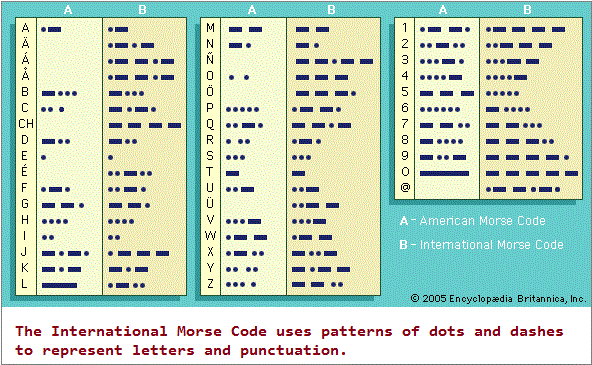 Source: "Morse Code." Encyclopædia Britannica Ultimate Reference Suite, 2013. |
A predominant "binary" orientation is being used to provide us with our current understanding of dimension. From a single point representing one dimension, to two points representing two dimensions, then a doubling thereof to four points in order to represent three dimensions and another doubling to represent multiple dimensions. In other words, with respect to ancient counting systems cropping up in the brains of modern humans as a fall-back position when confronted with complexity-of-quantity difficult to grasp coherently with the given set of language and thinking-related parameters in use: There is a distinct representation of a simplistic one, two, three, "Many" counting system being used in the formula "one— two, four, eight". This is a 3 to 1 ratio presented in a 1 to 3 ratio arrangement, where the doubled references are the "3" set next to a singular "1". In effect, there is a 1, 2, "Many" grouping and not an actual 1, 2, 3, many expression to suggest the expression of a "higher", more complex cognitive exercise... where in fact, something preceding the one- two- many ability is being applied. Again, the present conception of spatial dimension (one, two, three-dimensions)... is based on a binary perspective... a binary relativity. A trinary relativity would present us with a different perception of reality just as the helio- verses geocentric ideas of the cosmos did.

The usage of a binary system based on the dichotomous on/off switching of electrical circuitry may not be the electrical switching mechanism as alluded to in the above article. Despite the assumed "logic" of the system being used in different philosophical perspectives oriented towards a complementary (Yin/Yang) or oppositional (right/wrong) alignment used to correspond (and thus be an example of validation) to the adoption of a binary code... the numerous "three-patterned" examples found in a multitude of subject areas, suggests we are not utilizing the basic structure of atomic matter (electrons- neutrons- protons) with respect to its tripartite organization. For example, if we associate electrons with negative and protons with positive and neutrons with a neutral position... we must wonder if a deliberate focus on the extremes of an on/off circuitry is the result of an obsession with a "two" orientation because a "three" orientation requires the perspective of a different relativity? We must also wonder if the Neutron, in terms of electrical activity in the brain, has to contend with "noise" in the system? Whereas some readers may reflect on the behavior of "hearing voices", that some ancient Greeks interpreted to be a type of communication with a god... as a type of noise; is such a "noise" prevalent today but is hidden by people allowing themselves to be absorbed in the "voices" of television, radio and songs?
Clearly, if we say that the "neutron" is a position in which electrical activity is held in stasis, must deal with "noise", errors or some other interference... or is being subjected to a transformer in order to boost the charge for distances amongst neurons which may huge on an atomic scale... then we may also have to say that it is a position just as active but we are unable to correctly decipher the activity. But an obsession with the "two" in AI research is the ongoing exercise of a limitation that early peoples experienced in their primitive counting systems. In their own language equivalent way, early people developed a word which described the quantity ONE, then the quantity TWO, but afterwards assigned all other numbers to the realm of MANY. But AI research has not reached the expression of "Many". For example, when AI researchers try to tackle the problems of application to real-world human-based activity, the research is frequently divided by a "top down" or "bottom up" dichotomy. The awareness of a third reality is not in their vocabulary. Whereas reflexes can be labeled as binary actions, and that some brain tasks appear to work reflexively; the realization of a third entity is dismissed as being irrelevant or a fluke. Creating examples of artificial intelligence based on a dichotomy is fairly easy, but not so when intelligence is seen from a trichotomous vantage point.
Top Down AI perspectives are oriented towards a rote usage of a given knowledge base aligned with a given set of associated rules to be followed... like a blueprint from which housing units arise and give the impression of a "cookie cutter" parroting operation. It is an inflexible system which can not adequately function in an environment outside its knowledge base and associated rules... like a person experiencing culture shock; with no incorporated knowledge or rules which allow for parallels to be made by way of generalities. Such systems lack mechanisms of adaptation. Top Down perspectives are noted when dealing with many bureaucrats, or those in the employment of a government service... They have difficulty with situations which require thinking outside the conventions of their limited set of thinking skills... and is a main issue coming to the fore with respect to the public headed towards a revolt of the government that has rigged the system to favor it and is not flexibly adept at dealing with real-world problems outside the limitations of the present Constitution.
Bottom Up AI perspectives are oriented towards simplistic behavioral activities like teaching an infant to walk, talk, become self-aware, acquire hand-to-eye coordination, etc... Generally, such systems lack the sophistication of being able to think or perceive the world on their own.
In both cases of Top Down and Bottom Up, it should be realized that both systems are in effect in human behavior. Some people live in a Top Down world and others live in a simplistic Bottom Up world, even though they can communicate, on some level, with multiple others. In other words, both perspectives describe limitations that are already in usage on a biological level. Whereas we may use terms as strict, mule-headedness, simple-minded, uneducated, dumb, authoritarian, etc., such labels describe instances of Top Down and Bottom Up actors... The ability to drive a car, use a phone, pay for an item and thousands of other tasks are not indications of intelligence beyond the conventions of description. For example, though someone might consider that performing the task of solving a Rubic's Cube is an expression of intelligence, it may also mean that a person's brain is configured to such a performance. What we see is not intelligence, but the application of a Top Down routine being executed in an environment that the rules and knowledge of a particular person are adept with.
Top Down and Bottom Up orientations deal respectively, with complexity and simplicity. Similarly, if we look at AI efforts we can view it as a complex circle using a calculus to create a better grasp by introducing simple divisions, like reverse engineering or by attempting to itemize individual parts to see how they inter-relate. The following image is illustrative:
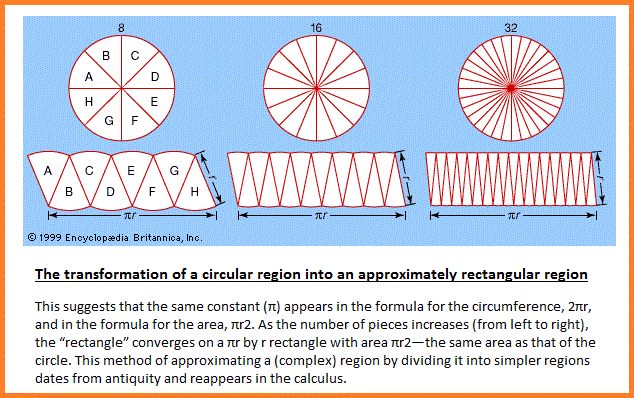
But present AI researchers are not using a three-based linear and/or circular and/or triangular method. They are using what might be described another attempt at "squaring the circle"... that is, instead of using a three-based triangular basis for differentiating, they are using two-based squares called binary with the aid of a mechanical instrument. Let us look at an historical reference to the subject of squaring-the-circle:
| Squaring the circle The pre-Euclidean Greek geometers transformed the practical problem of determining the area of a circle into a tool of discovery. Three approaches can be distinguished:
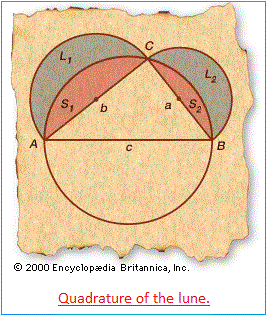
While not able to square the circle, Hippocrates did demonstrate the quadratures of lunes; that is, he showed that the area between two intersecting circular arcs could be expressed exactly as a rectilinear area and so raised the expectation that the circle itself could be treated similarly. A contemporary of Hippias's discovered that the quadratrix could be used to almost rectify circles. These were the substitution and mechanical approaches. [Hippocrates demonstrated that the moon-shaped areas between circular arcs, known as lunes, could be expressed exactly as a rectilinear area, or quadrature.] The method of exhaustion as developed by Eudoxus approximates a curve or surface by using polygons with calculable perimeters and areas. As the number of sides of a regular polygon inscribed in a circle increases indefinitely, its perimeter and area “exhaust,” or take up, the circumference and area of the circle to within any assignable error of length or area, however small. In Archimedes' usage, the method of exhaustion produced upper and lower bounds for the value of (pi), the ratio of any circle's circumference to its diameter. This he accomplished by inscribing a polygon within a circle, and circumscribing a polygon around it as well, thereby bounding the circle's circumference between the polygons' calculable perimeters. He used polygons with 96 sides and thus bound [(pi) between 3 10/71 and 3 1/7.] Sources: "Geometry", "Quadrature of the Lune." Encyclopædia Britannica Ultimate Reference Suite, 2013. |
The Binary perspective has long been used as a type of divination tool. The Chinese have used it in terms of the I Ching and other cultures have adopted their own uses of a binary standard to represent superior "Intelligence" existing within a code, just like those using it for the bases of computer programming.
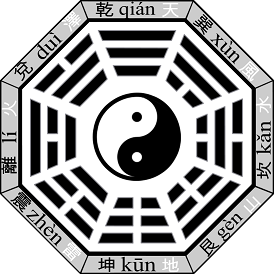
...Though the (I Ching: Yijing) book was originally used for divination, its influence on Chinese minds and its universal popularity are due to a cosmology that involves humans and nature in a single system. The uniqueness of the Yijing consists in its presentation of 64 symbolic hexagrams that, if properly understood and interpreted, are said to contain profound meanings applicable to daily life. Throughout the ages, Yijing enthusiasts have claimed that the book is a means of understanding, and even controlling, future events. The Yijing hexagrams are formed by joining in pairs, one above the other, eight basic trigrams (bagua). Each trigram has a name, a root meaning, and a symbolic meaning. The legendary emperor Fuxi is said to have discovered these trigrams on the back of a tortoise. Wenwang is generally credited with having formed the hexagrams. In practice, one “creates” a hexagram by casting lots in one of several ways. The hexagram is built up from the bottom, line by line, by successive lots. Solid lines have the number nine, and broken lines have the number six. Solid lines represent yang (the male cosmic principle), while broken lines represent yin (the female cosmic principle). These two principles explain all being and all change by their ceaseless interaction. Individual lines of a hexagram have been compared to single notes of music. Though each note has a quality and significance in itself, its truest significance depends on its place in a musical score. Because the same principle applies to individual lines of a hexagram, the Yijing text first explains each line separately, then gives an overall interpretation of the unit. The text is often expressed in cryptic, thought-provoking language, thus allowing the user great leeway in interpreting its significance. Commentary Source: "Yijing." Encyclopædia Britannica Ultimate Reference Suite, 2013.Image Source: Wikipedia: Binary Code |
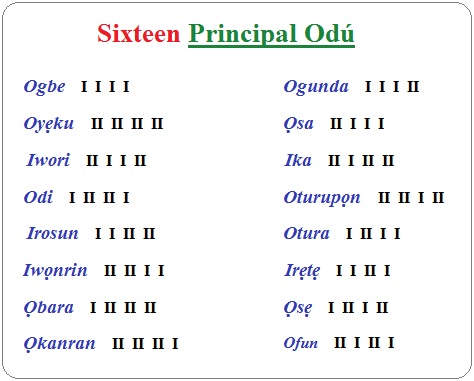 |
Ifá is the ancient system of divination and literary corpus of the Yoruba people of Nigeria. In Yoruba religion, the rite provides a means of communication with spiritual divinity. The Orisa Ifá or Orunmila ("Grand Priest") permits access to an initiated priest, a Babalawo ("father of the secrets") who generates binary values using sacred palm nuts. In wood powder, these are recorded as single and double lines. There are 16 principal Od ú that are said to compose the 256 Od ú. From memory alone, a Babalawo must be able to recite four to ten verses for each of the 256 Od ú Ifá generally, orisa lore, traditional medicine, and ritual advice. In 2005, UNESCO listed If á in the Masterpieces of the Oral and Intangible Heritage of Humanity. Source: Wikipedia: Binary Code |
Another type of binary code is seen in the system of reading and writing known as Braille, but rightly should also be identified as a system of thinking and perception. It should be distinguished from a three-patterned system of thinking and perception, and those perceptions involving mixtures thereof. Variations of other patterned orientations should likewise be represented as different types, though a perception may claim to use one more than another when they actually do not... as if to convey a superiority of orientation.
At this point, a bit of history about writing for the blind is in order, making note of a "63" formula instead of a "64" model:
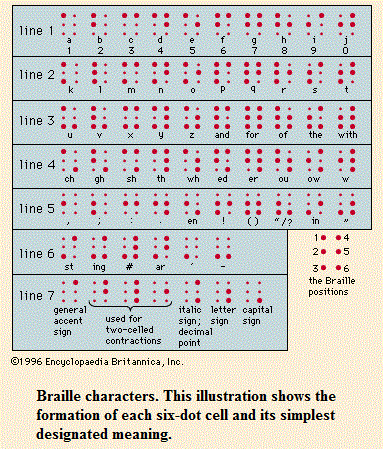
Valentin HaÜy, was a French professor of calligraphy known as the “father and apostle of the blind.” He was the brother of René-Just HaÜy. After seeing a group of blind men being cruelly exhibited in ridiculous garb in a Paris sideshow, HaÜy decided to try to make the life of the blind more tolerable and help them gain a sense of usefulness. He set out by hiring a blind beggar boy to submit to instruction. In 1784 he established the National Institution for Blind Youth, Paris (afterward a state-supported school for blind children), where Louis Braille, inventor of the most widely used alphabet for the blind, was a student and later a teacher; in 1785 the school was renamed the Royal Institution for Blind Youth. HaÜy fore-shadowed Braille's work by discovering that sightless persons could decipher texts printed in embossed letters and by successfully teaching blind children to read. Source: "HaÜy, Valentin." Encyclopædia Britannica Ultimate Reference Suite, 2013.The Frenchman Valentin HaÜy was the first person to emboss paper as a means of reading for the blind. His printing of normal letters in relief led others to devise simplified versions; but, with one exception, they are no longer in use. The single exception is Moon type, invented in 1845 by William Moon of Brighton, England, which partly retains the outlines of the Roman letters and is easily learned by those who have become blind in later life. Books in this type are still in limited use by elderly people, particularly in Great Britain. When Louis Braille entered the school for the blind in Paris, in 1819, he learned of a system of tangible writing using dots, invented in 1819 by Capt. Charles Barbier, a French army officer. It was called night writing and was intended for night-time battlefield communications. In 1824, when he was only 15 years old, Braille developed a six-dot “cell” system. He used Barbier's system as a starting point and cut its 12-dot configuration in half. The system was first published in 1829; a more complete elaboration appeared in 1837. Source: "Braille." Encyclopædia Britannica Ultimate Reference Suite, 2013. |
It is necessary for the reader not to overlook the usage of two lines of three dots which has a similar alignment with the usage of two rows of eight game pieces such as in chess and checkers. Clearly, it might be suggested that a "63" value in Braille gives us an indication of an imperfect "64" system... meaning that further improvement is needed if one is desirous to conform to the 64-arrangement structure. The side-by-side or front-and-back alignment can give the impression of arranging sticks into a grouping, like holding one stick in one hand and one stick in the other, or two separate people holding items of barter. Hence, the opposing players on a chess board are teams of barterers... of a sort... like double-entry accounting.
Subject page first Originated (saved into a folder): Thursday, November 13, 2014... 5:50 AM
Page re-Originated: Sunday, 24-Jan-2016... 08:51 AM
Initial Posting: Saturday, 13-Feb-2016... 10:59 AM
Updated Posting: Sunday, 23-June-2019... 2:24 PM
Herb O. Buckland
herbobuckland@hotmail.com